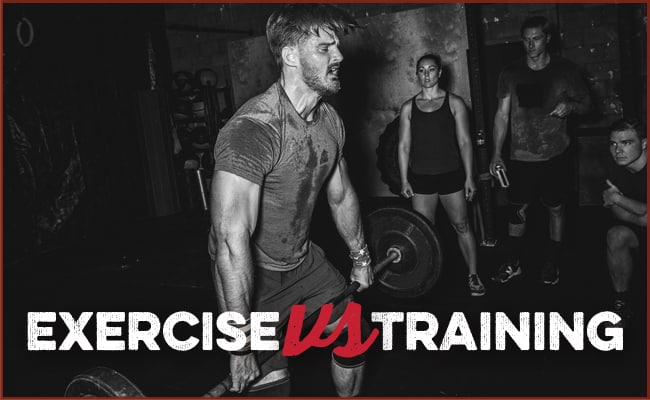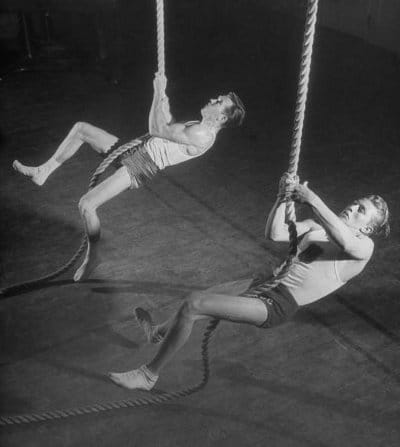
When it comes to fitness, the words “exercise” and “training” are often used interchangeably.
A guy who regularly goes to the gym and randomly does some weight machines and a little cardio might say he’s training. This same guy is frustrated that he’s not making any progress with his strength or appearance despite his regular training.
The problem is, that guy is actually exercising and not training.
The distinction between the words “exercise” and “training” might seem pedantic, but understanding it can be an important step in realizing your fitness goals.
Today, we’ll dig into the difference between these two ideas.
What Is Exercise?
Let’s start by defining exercise. Exercise can be described as any physical activity that enhances or maintains physical fitness and overall health in a general way. The aim with exercise is to vigorously move your body so you burn some calories, get hot and sweaty, and maybe feel a pump. Some people exercise so they can generate feel-good endorphins or stay in decent shape.
There’s nothing wrong with exercise. Regular vigorous exercise provides tons of benefits, including enhanced heart health, mood, and sleep quality. Regularly moving your body can help regulate your metabolism and keep your weight in check.
While exercise is universally acknowledged as beneficial, it’s not training. Training goes beyond mere exercise.
What Is Training?
When someone says they are training, it means they are actively working towards improving a specific aspect of their physical performance. It could be they’re trying to get stronger, run further/faster, or improve their physique.
Achieving these goals requires taking a systematic and intentional approach to exercise. Training is that systematic and intentional approach.
When you’re training, you’re following a program that’s intentionally designed to elicit adaptations so that you can improve a given capacity.
For example, if you want to get stronger, you have to follow a program where progressive overload takes place. For strength-producing adaptations to occur, you must increasingly add stress to your muscles and your neuromuscular system by lifting heavier and heavier weights or varying the degrees of volume or frequency in your reps/sets. The most basic strength training program takes the form of linear progression, where you add weight to the bar every workout until you can no longer do so. Once that happens, you have to modify your training program by adjusting reps, sets, and frequencies. All these changes are made through the lens of the training paradigm: systematically and intentionally engaging in physical activity to reach the goal of getting stronger.
If you’re a runner, training would involve following a program with varying degrees of intensity and volume over a long period of time in order to run further and faster.
Lately, my fitness goal has been to get bigger and chisel my physique. Consequently, my training is designed with those aims in mind. I’m following a program designed to work certain muscle groups and am adding weight and reps each workout so that I can stimulate my muscles to grow.
The distinguishing factor between exercise and training lies in the intention and focus. Exercise doesn’t require a program and isn’t done with a concrete outcome in mind. Training aims to condition the body to operate at a higher level and achieve specific goals. It requires a plan, dedication, and a commitment to progress over time.
While training is commonly associated with sports or athletic pursuits, it’s not limited to the arena of physical pursuits. You can extend it to other domains like music, writing, and marksmanship as well. Take music: You can pick up a guitar and strum some random tunes for a half hour every day simply because you enjoy it. While approaching the guitar like this can be enjoyable, it doesn’t guarantee that you’ll get any better. Improving will require you to intentionally design a practice program that hones your skills. Getting better requires deliberate practice. Training is just another way of saying “deliberate practice.”
Exercise or Training: Which Is Right for You?
So, which approach should you adopt, exercise or training? The answer depends on your individual goals and priorities. If your primary objective is to maintain overall health and well-being, exercise alone is generally sufficient. You have the freedom to choose activities that you enjoy and that align with your lifestyle. Whether it’s hiking, ultimate frisbee, or playing pick-up basketball, as long as you’re getting 60 minutes a day of activity, you should be good for maintaining overall physical and mental health.
However, if you aspire to become stronger, build muscle, or improve your 5k time, you can’t just exercise; you have to train. These goals require a more structured and intentional approach.
If you feel content with your exercise routine, keep at it.
If you’ve been feeling frustrated that despite working out regularly, you haven’t been making any progress with your fitness, then maybe it’s time to switch from exercising to training.







